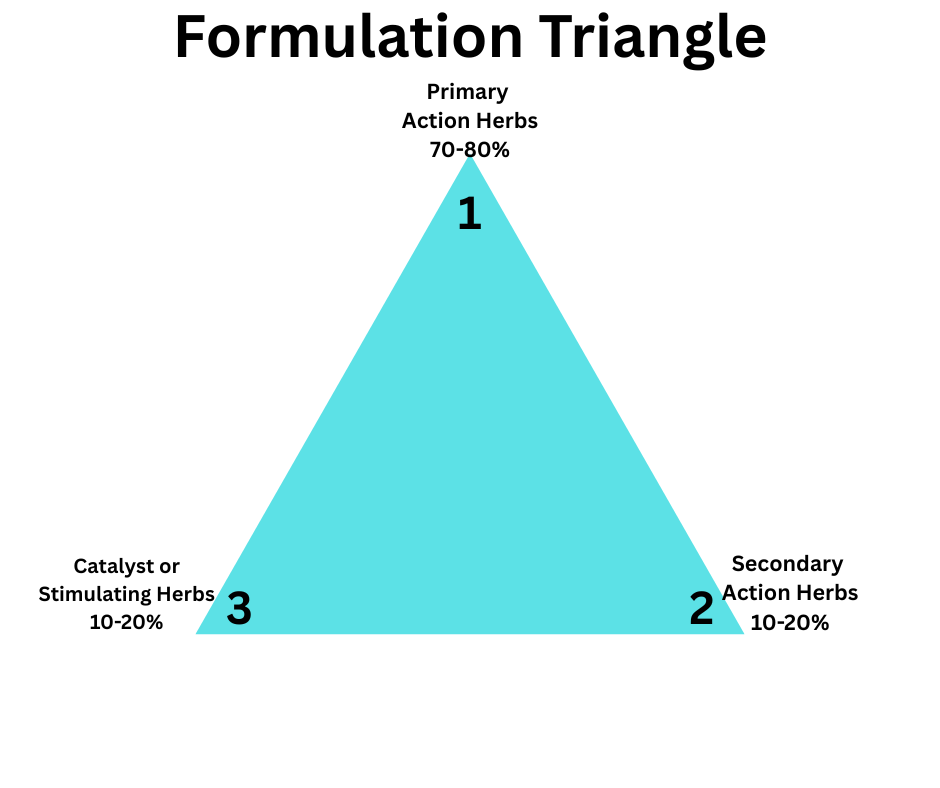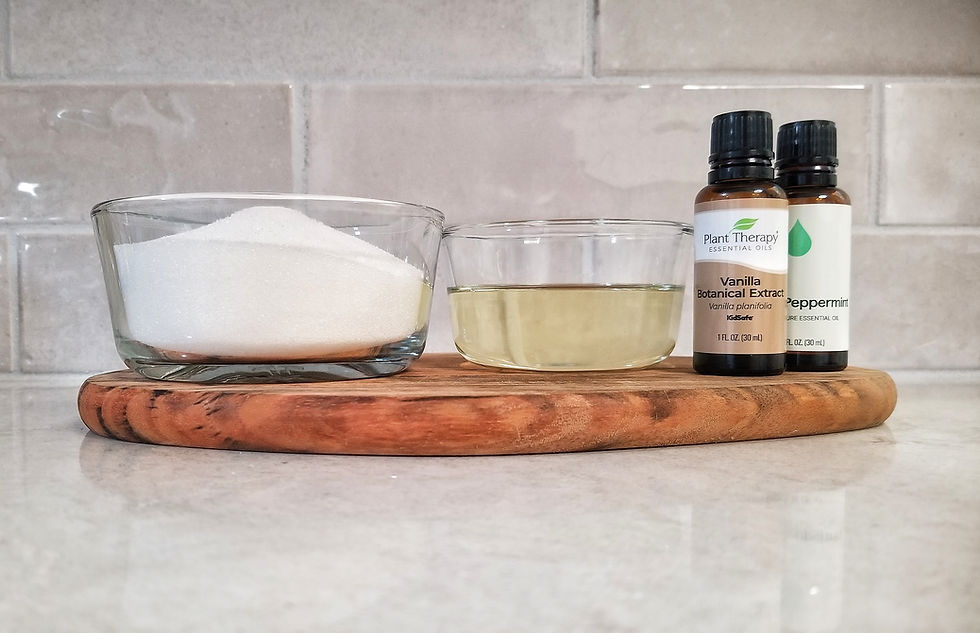Understanding the Formulation Triangle for Herbal Blends
- Jean McCabe
- Sep 25
- 6 min read

A Step-by-Step Instructional Guide for Herbalists and Wellness Enthusiasts
The Formulation Triangle: A Framework for Crafting Herbal Blends
The Formulation Triangle is a practical framework used by many herbalists to create effective and balanced herbal blends. This approach organizes herbs into three distinct categories: Primary Action Herbs, Secondary Action Herbs, and Catalyst or Stimulating Herbs. By categorizing herbs in this way, you can ensure your blends are purposeful, synergistic, and tailored to meet your specific needs.
Using the Formulation Triangle, you will learn how to clearly define the purpose of your blend, thoughtfully select herbs for each category, determine appropriate proportions, and apply the method through real-life examples. This structured approach makes the process of herbal blending approachable and rewarding for everyone, whether you are an experienced herbalist or just starting your wellness journey.
The Formulation Triangle Approach
In developing effective herbal blends, the Formulation Triangle serves as a central guide. This method, as taught by Heidi Villegas at Healing Harvest Homestead School of Botanical Arts and Sciences, provides a clear and logical framework for selecting and balancing herbs within a blend. Each step of the blending process is informed by the triangle’s structure, ensuring that every component of your blend is chosen with intention. By following this method, you create herbal blends that are not only effective but also well-rounded and thoughtfully composed.
Step 1: Defining the Purpose/Intention of Your Blend
Clarifying the Purpose of Your Herbal Blend
Before selecting any herbs for your blend, it is essential to establish a clear and focused purpose. Start by asking yourself what specific outcome you want to achieve with the blend. For example, your goals may include calming nerves, supporting healthy digestion, boosting immunity, or addressing another particular wellness concern.
Additionally, take into account the age and overall health of the individual for whom the blend is intended. By considering these details, you ensure that the blend is tailored to the unique needs and circumstances of the user, setting a strong foundation for the rest of the formulation process.
Take time to write out your intention in a single, concise sentence. For example, you might state, “I want to create a blend that eases occasional anxiety and promotes relaxation.” This clearly defined purpose will serve as the foundation for all decisions you make throughout the formulation process, guiding your selection of herbs and ensuring that your blend is purposeful and effective.
Tips for Defining Purpose:
Be specific about the desired outcome.
Consider the blend’s intended user: adults, children, etc.
Think about whether the need is acute (short-term) or chronic (long-term).
Step 2: Selecting Primary Action Herbs
Step 2: Selecting Primary Action Herbs
The Primary Action Herbs serve as the foundation of your herbal blend, acting as the main agents to address your specific purpose or concern. These herbs are considered the powerhouse of the formula, chosen for their direct and substantial support of the intended outcome. Typically, Primary Action Herbs comprise 70–80% of the overall blend.
As you review the herbs selected for this category and consider the reasons behind each choice, evaluate whether one herb stands out as particularly beneficial, or if multiple herbs offer comparable advantages. This assessment will help ensure that your blend is both effective and balanced.
Let’s Review the Criteria for Primary Herb Selection:
Directly supports your blend’s goal.
Has a strong, reliable effect.
Safe for the intended user and use duration.
Examples:
For relaxation: Lavender, Lemon Balm, Passionflower
For immune support: Echinacea, Elderberry
Step 3: Choosing Secondary Action Herbs
Secondary Action Herbs: Supporting and Balancing the Blend
Secondary Action Herbs play a vital role in supporting the body system targeted by your herbal formula. These herbs are typically selected for their nutritive and toning properties, contributing to overall wellness and balance. In some cases, secondary herbs are chosen specifically to counteract or moderate the actions of the primary herbs, ensuring a harmonious and effective blend.
When formulating your blend, secondary herbs should comprise approximately 10–20% of the total formula. As you review your selected herbs for this category, consider the reasons for each choice. Evaluate whether one herb stands out as particularly beneficial or if multiple herbs offer similar advantages. This assessment helps determine the most suitable combination for your blend, ensuring that the secondary herbs effectively support or balance the primary action while contributing essential nutrition and toning effects.
Let’s Review the Roles of Secondary Herbs:
Support or enhance the primary action.
Counterbalance strong effects (e.g., add soothing herbs to a stimulating blend).
Provide nutrition or toning (e.g., Nettle for minerals).
Examples:
For relaxation: Chamomile, Oat Straw
For immune support: Rosehips (vitamin C), Astragalus
Step 4: Adding Catalyst or Stimulating Herbs
Catalyst or Stimulating Herbs
Catalyst or stimulating herbs are a key component in herbal formulas, serving to activate both the main and supporting herbs in the blend. By promoting the movement of herbs throughout the body, these herbs help ensure that the entire formula works effectively and efficiently.
Typically, catalyst or stimulating herbs make up about 10–20% of the total herbal formula. This proportion allows them to enhance the overall impact without overwhelming the other ingredients. Depending on your formulation, you may choose to include a single catalyst herb or combine several that share similar properties.
In addition to their activating role, many catalyst herbs also contribute positively to the flavor profile of the blend, making the preparation more palatable and enjoyable to consume.
Let’s Review the Functions of the Catalyst Herbs:
Stimulate physiological processes (e.g., digestion, circulation).
Increase the synergy or absorption of the blend.
Examples:
Ginger (circulation, digestion)
Licorice (harmonizer, sweetener)
Cayenne (stimulating)
A Note on Choosing the Appropriate Herb Category
The placement of an herb within a formula depends largely on the intended purpose of the blend. The selection process is guided by the specific therapeutic goal you wish to achieve. For example, while ginger is commonly recognized as an effective catalyst herb, its categorization may shift depending on the focus of your formula. If you are creating a blend targeting digestive health, ginger’s primary benefits for digestion make it more appropriate to include as a Primary Action Herb. In this case, ginger would not be counted within the Catalyst or Stimulating Herbs portion, but rather in the section dedicated to Primary Action Herbs, which are chosen for their direct contribution to the formula’s main purpose.
Step 5: Determining Proportions
Proper proportions are essential for a balanced and effective blend. It’s easier to use a “10-part system” to make measuring easier.
Primary Action Herbs: 70-80% (7-8 parts)
Secondary Action Herbs: 10-20% (1-2 parts)
Catalyst/Stimulating Herbs: 10-20% (1-2 parts)
“Parts” can be any unit of measure (teaspoon, tablespoon, ounce, 1/4 cup, etc.) as long as you’re consistent.
Category | Parts | Percentage |
Primary | 7 | 70% |
Secondary | 2 | 20% |
Catalyst | 1 | 10% |
Step 6: Practical Application—Example Blend Walkthrough
Let’s walk through creating a blend for relaxation:
Purpose: “To promote relaxation and ease occasional anxiety.”
Primary Action Herbs (7 parts): Lemon Balm (calming), Passionflower (nervine)
Secondary Action Herbs (2 parts): Chamomile (soothing), Oat Straw (nourishing)
Catalyst Herb (1 part): Ginger (improves absorption, gently warming)
Proportions: Use tablespoons as “parts:
4 tbsp. Lemon Balm
3 tbsp. Passionflower
1 tbsp. Chamomile
1 tbsp. Oat Straw
1 tbsp. Ginger
For acute use (e.g., sudden stress), emphasize faster-acting herbs.
For chronic use (e.g., ongoing tension), include more nutritive and toning herbs to support long-term wellness.
Always adjust based on individual needs and responses.
Conclusion
The Formulation Triangle Method: Bringing Clarity to Herbal Blending
The Formulation Triangle method is a valuable approach that provides structure and clarity when creating herbal blends. By defining specific categories for herbs—primary action, secondary action, and catalysts, this method ensures each ingredient serves a distinct purpose within the blend.
Adjusting Proportions in Practice
While the Formulation Triangle offers general guidelines, it is important to recognize that herbalists may use slightly different proportions to suit their preferences and experience. For example, Rosemary Gladstar recommends using 70-80% of the blend as primary action herbs, 15-20% as secondary action herbs, and 5-10% as catalyst herbs. These percentage ranges allow for flexibility while maintaining the integrity of the blend.
Thoughtful Selection and Purpose
Regardless of the specific percentages chosen, both Heidi Villegas and Rosemary Gladstar’s approach emphasize the importance of clearly defining the purpose of the blend. Thoughtful selection of herbs for each category, along with careful adherence to recommended proportions, helps create blends that are not only effective but also harmonious in their effects.
Experimentation and Refinement
Herbalism is both an art and a science. Do not hesitate to experiment with different herbs and proportions, as personal experience will help you refine your craft. With each blend, you gain valuable insights into what works best for your needs and preferences. Happy blending!




Comments